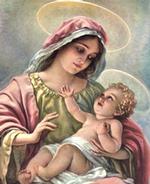Catholic World News News Feature
Turf battle between Swiss Guard, Vatican police? September 19, 2005
Italian news media are reporting tensions between the Swiss Guard and the regular Vatican police force, over conflicting plans for assuring the security of the Pope.
The death of Pope John Paul II and election of Benedict XVI reportedly triggered the latest in a long-running series of jurisdictional disputes between the Vatican's two armed security services. The massive influx of mourners after the death of the beloved John Paul II-- including many prominent figures who had their own security concerns-- combined with the threat of terrorist attacks to put unprecedented demands on the forces dedicated to the safety of the Vatican. That set the stage for the latest episode of an intramural conflict that has endured for generations.
After the death of John Paul II, the Italian daily Corriere della Sera reports, the current commandant of the Swiss Guard, Elmar Theodor Mäder, wrote a memo to top Vatican officials emphasizing the role of his unit as the primary force offering protection for the Roman Pontiff. The tone of that memo apparently ruffled the feathers of other Vatican security officials.
During the coming year the Swiss Guard will celebrate the 500th anniversary of its founding. The Swiss Guard take great pride in their historic role, and Mäder emphasized that heritage in his memo. But some Vatican observers felt that the commandant was making a bid to expand the prestige and authority of the Swiss Guard, to the detriment of the Vatican police force.
Such skepticism increased after the election of Benedict XVI. Critics began to theorize that the Swiss Guard-- most of whose members are German-speaking-- hoped to capitalize on the election of a German Pontiff to expand their sphere of influence.
The formal responsibilities of the Swiss Guard are the personal protection of the Holy Father, the security of the apostolic palace, and the guarding of several entrances to the Vatican. The corps has always sought to maintain a constant and visible presence around the Roman Pontiff, and at least two members of the Swiss Guard have traveled with the Pope, whenever he has left the Vatican. However, the members of the Swiss Guard have not worn their distinctive uniforms outside the Vatican; when they act as bodyguards during papal trips, they dress in civilian clothes. One exception to that rule was made in June 2004, when Pope John Paul II traveled to the Swiss capital, Bern. In a special gesture honoring the Swiss unit, the members of the Guard wore their uniforms on that occasion.
The Swiss Guard apparently hoped for a change in that general policy after the election of Benedict XVI. Less than a month after his election, when the Holy Father traveled to Bari, Italy, for the National Eucharistic Congress, he was accompanied by two members of the Swiss Guard in full uniform. But the Pope's only subsequent foreign trip, to Cologne for World Youth Day in August, saw no new breaks from regular Vatican protocol.
The Swiss Guard also seek to take over responsibility for certain entrances to the Vatican which are now controlled by the Vatican police force. And to allow for these new duties, the Guard seeks an increase in size: from 110 to 130 members, bringing the historic unit up to the size of the Vatican police force.
Despite their illustrious history, the Swiss Guard have suffered setbacks in prestige, and serious recruitment problems, in recent years. The force was badly shaken by the assassination of the commandant, Alois Estermann, who was killed alongside his wife in 1998. Another member of the Guard, Cedric Tornay, was found to have killed the couple before taking his own life on the spot. But the bloody deaths gave rise to a variety of rumors and conspiracy theories, marring the proud reputation of the papal guard.
Largely because of that ugly incident, the Swiss Guard have suffered morale problems. For the past few years, about 70 percent of all new recruits to the corps have left after a single 2-year enlistment period, making it difficult to establish a veteran presence. At the same time, the police force has been entrusted with more and more responsibility for security concerns in the tiny Vatican city-state. While it is much less visible than the Swiss Guard, the police force has its own history, having been formed by Pope Pius VII in 1816 to maintain public order inside the grounds of the Vatican and at the papal summer residence in Castel Gandolfo. This force has also supplied security when Pope John Paul, and then Benedict XVI, took summer vacations in the Italian Alps. According to Corriere della Serra, the police force enjoyed the favor of John Paul II. It also enjoyed the benefit of cooperation with Italian security officials, as international cooperation advanced in response to the terrorist threat. The budget provided to the police force for training and equipment rose every year after the assassination attempt on John Paul II in May 1981, Corriere reports.
Any tensions that might exist between the Swiss Guard and the Vatican police raise questions about the efficiency of coordination between the two Vatican security forces. Those questions are complicated by the fact that Italian police also are also routinely involved in questions involving the security of the Pope and the Vatican. According to some informed officials, the three forces-- Swiss Guard, Vatican police, and Italian police-- did not share a single coordinated communication system during the trip by Pope Benedict to Bari.






